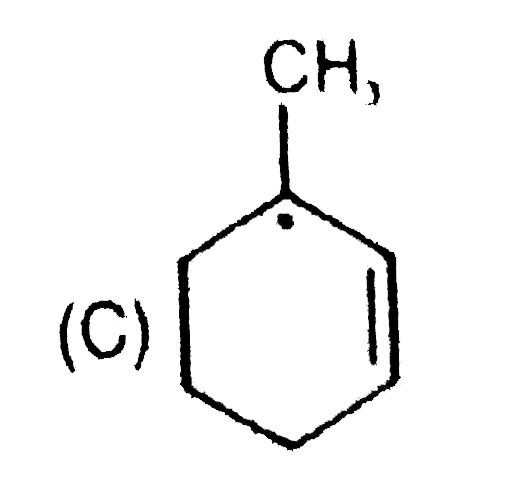The most stable radical among the following is :
CH2−CH⋅2∣NO2
CH2−CH⋅2∣COO−
C2−CH⋅2∣CH3
CH2−CH⋅2∣O−
The correct Answer is:D
To determine the most stable radical among the given options, we need to analyze the nature of the substituents attached to each radical and their effects on stability.
1. Identify the radicals: We have four radicals to consider. Let's denote them as:
- Radical A
- Radical B
- Radical C
- Radical D
2. Understand radical stability: Free radicals are species with an unpaired electron. Their stability is influenced by the presence of substituents that can either donate or withdraw electron density. Electron-donating groups (EDGs) can stabilize radicals, while electron-withdrawing groups (EWGs) can destabilize them.
3. Analyze the substituents:
- Radical A: Contains an electron-withdrawing group (e.g., NO2 or COO-).
- Radical B: Contains an electron-withdrawing group (e.g., NO2 or COO-).
- Radical C: Contains an electron-donating group (e.g., CH3).
- Radical D: Contains an electron-donating group (e.g., O-CH3).
4. Evaluate the effects of substituents:
- For Radicals A and B: The presence of electron-withdrawing groups (NO2 or COO-) will destabilize the radicals due to the -I effect, which pulls electron density away from the radical center.
- For Radical C (CH3): The methyl group (CH3) is an electron-donating group, but it is not as effective as other groups in stabilizing radicals.
- For Radical D (O-CH3): The methoxy group (O-CH3) has an oxygen atom that can donate electron density more effectively than a carbon atom. The oxygen has a lone pair of electrons that can help stabilize the radical.
5. Conclusion: Among the radicals analyzed, Radical D (O-CH3) is the most stable due to the strong electron-donating ability of the oxygen atom, which stabilizes the unpaired electron in the radical.
Final Answer:
The most stable radical among the given options is Radical D (O-CH3).
---
- Radical A
- Radical B
- Radical C
- Radical D
- Radical A: Contains an electron-withdrawing group (e.g., NO2 or COO-).
- Radical B: Contains an electron-withdrawing group (e.g., NO2 or COO-).
- Radical C: Contains an electron-donating group (e.g., CH3).
- Radical D: Contains an electron-donating group (e.g., O-CH3).
- For Radicals A and B: The presence of electron-withdrawing groups (NO2 or COO-) will destabilize the radicals due to the -I effect, which pulls electron density away from the radical center.
- For Radical C (CH3): The methyl group (CH3) is an electron-donating group, but it is not as effective as other groups in stabilizing radicals.
- For Radical D (O-CH3): The methoxy group (O-CH3) has an oxygen atom that can donate electron density more effectively than a carbon atom. The oxygen has a lone pair of electrons that can help stabilize the radical.
The most stable radical among the given options is Radical D (O-CH3).
Topper's Solved these Questions
Similar Questions
Knowledge Check
Least stable radical among the following is :
A B
B C
C D
D
The most stable free radical among the following is
AC6H5CH2CH2BC6H5CHCH3CCH3CH2DCH3CHCH3The most stable free radical among the following is
AC6H5CH2⋅CH2BC6H5⋅CHCH3CCH3⋅CH2DCH3⋅CHCH3
The most stable complex among the following is
View SolutionThe most stable complex among the following is
View SolutionThe most stable complex among the following is
View SolutionThe most stable complex among the following is
View SolutionThe most stable complex among the following is
View Solution
